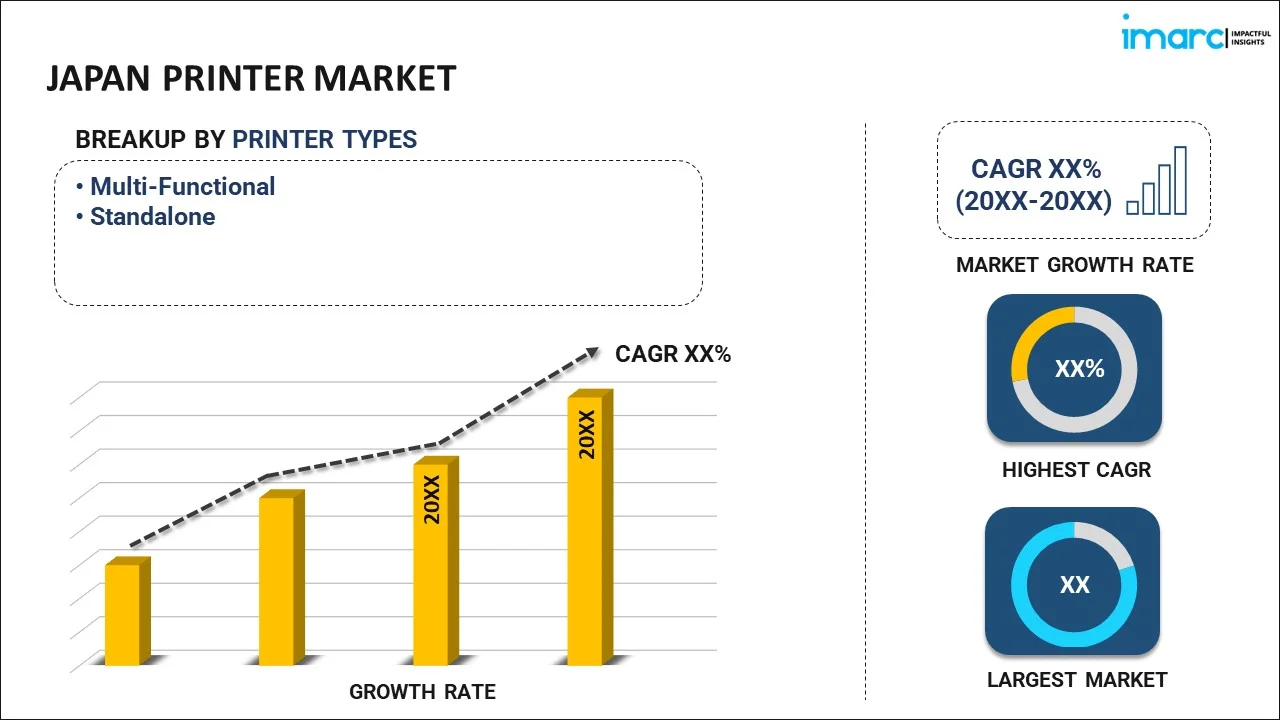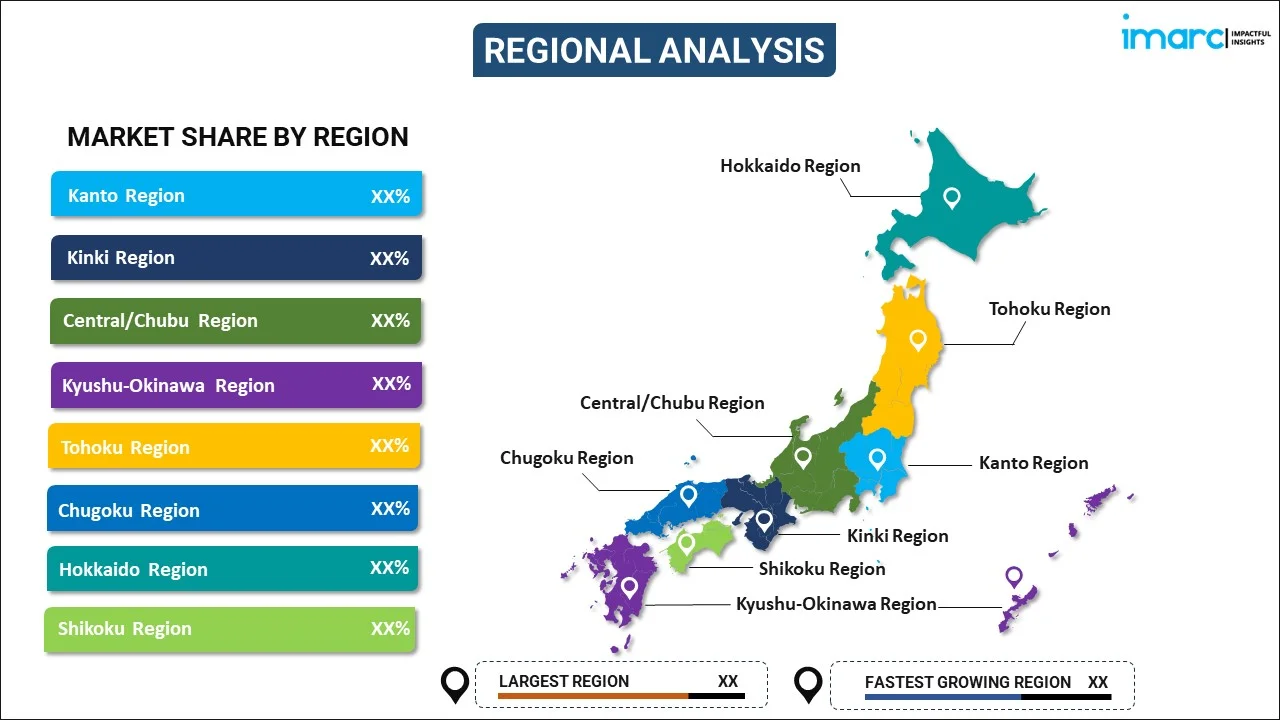
Japan Printer Market Report by Printer Type (Multi-Functional, Standalone), Technology Type (Dot Matrix Printer, Inkjet Printer, LED Printer, Thermal Printer, Laser Printer), Printer Interface (Wired, Wireless), End User (Residential, Commercial, Educational Institutions, Enterprises, Government, and Others), and Region 2025-2033
Market Overview:
The Japan printer market size reached USD 2.9 Million in 2024. Looking forward, IMARC Group expects the market to reach USD 4.3 Million by 2033, exhibiting a growth rate (CAGR) of 4.3% during 2025-2033. The growing need for physical copies of documents, contracts, and reports in offices, rising number of schools, colleges, and universities that are adopting a hybrid learning approach, and increasing demand for devices that cater to remote working requirements represent some of the key factors driving the market.
|
Report Attribute
|
Key Statistics
|
|---|---|
|
Base Year
|
2024 |
|
Forecast Years
|
2025-2033
|
|
Historical Years
|
2019-2024
|
| Market Size in 2024 | USD 2.9 Million |
| Market Forecast in 2033 | USD 4.3 Million |
| Market Growth Rate (2025-2033) | 4.3% |
A printer is a peripheral device commonly used in offices, homes, and various industries to produce physical copies of digital documents or images stored on a computer or other electronic devices. It comprises inkjet printers and laser printers wherein inkjet printers work by spraying tiny droplets of ink onto the paper, while laser printers use a laser to transfer toner powder onto the paper, which is then fused using heat. It is crucial in the publishing industry, wherein it produces books, magazines, newspapers, and other printed materials. It plays a key role in facilitating the transition from digital to tangible information, making it more accessible and shareable in physical form. It assists in producing documents like reports, memos, presentations, and spreadsheets. It enables easy dissemination of information among colleagues and clients. It also produces high-quality prints from digital images, allowing photographers to showcase their work. It is used to create brochures, flyers, posters, and banners for marketing campaigns and promotional activities. It is also utilized to generate study materials, handouts, assignments, and exam papers in schools and universities. As it is employed to replicate digital content onto paper using various printing technologies, the demand for printer is rising in Japan.
Japan Printer Market Trends:
At present, the increasing need for physical copies of documents, contracts, and reports in offices represents one of the key factors supporting the growth of the market in Japan. Moreover, the growing demand for printers, particularly those equipped with advanced features like wireless connectivity and cloud integration, is offering a favorable market outlook. Besides this, the rise in remote work arrangements, accelerated by recent global events, is catalyzing the demand for personal printer purchases in the country. As employees are working from home, the necessity for efficient and reliable home office equipment is rising in Japan. Consequently, the market is experiencing an increase as individuals are seeking devices that cater to their remote working requirements. In addition, the growing number of schools, colleges, and universities that are adopting a hybrid learning approach is catalyzing the demand for printers that offer cost-effective and high-quality printers in the country. Apart from this, the adoption of environmentally conscious practices in Japan is influencing the market. People are increasingly opting for eco-friendly printers that incorporate sustainable features like energy efficiency and recycled materials. As environmental concerns become a priority for both businesses and consumers, printer manufacturers are aligning their offerings accordingly in Japan. Furthermore, the proliferation of e-commerce and online businesses is contributing to the expansion of the market in the country. In line with this, the increasing utilization of printers in small and medium-sized enterprises for order fulfillment, shipping labels, and packaging materials is bolstering the growth of the market.
Japan Printer Market Segmentation:
IMARC Group provides an analysis of the key trends in each segment of the Japan printer market report, along with forecasts at the country level for 2025-2033. Our report has categorized the market based on printer type, technology type, printer interface, and end user.
Printer Type Insights:

- Multi-Functional
- Standalone
The report has provided a detailed breakup and analysis of the market based on the printer type. This includes multi-functional and standalone.
Technology Type Insights:
- Dot Matrix Printer
- Inkjet Printer
- LED Printer
- Thermal Printer
- Laser Printer
A detailed breakup and analysis of the market based on the technology type has also been provided in the report. This includes dot matrix printer, inkjet printer, LED printer, thermal printer, and laser printer.
Printer Interface Insights:
- Wired
- Wireless
A detailed breakup and analysis of the market based on the printer interface has also been provided in the report. This includes wired and wireless.
End User Insights:
- Residential
- Commercial
- Educational Institutions
- Enterprises
- Government
- Others
A detailed breakup and analysis of the market based on the end user has also been provided in the report. This includes residential, commercial, educational institutions, enterprises, government, and others.
Regional Insights:

- Kanto Region
- Kinki Region
- Central/ Chubu Region
- Kyushu-Okinawa Region
- Tohoku Region
- Chugoku Region
- Hokkaido Region
- Shikoku Region
The report has also provided a comprehensive analysis of all the major regional markets, which include Kanto Region, Kinki Region, Central/ Chubu Region, Kyushu-Okinawa Region, Tohoku Region, Chugoku Region, Hokkaido Region, And Shikoku Region.
Competitive Landscape:
The report has also provided a comprehensive analysis of the competitive landscape in the Japan printer market. Competitive analysis such as market structure, key player positioning, top winning strategies, competitive dashboard, and company evaluation quadrant has been covered in the report. Also, detailed profiles of all major companies have been provided.
Japan Printer Market Report Coverage:
| Report Features | Details |
|---|---|
| Base Year of the Analysis | 2024 |
| Historical Period | 2019-2024 |
| Forecast Period | 2025-2033 |
| Units | Million USD |
| Scope of the Report | Exploration of Historical and Forecast Trends, Industry Catalysts and Challenges, Segment-Wise Historical and Predictive Market Assessment:
|
| Printer Types Covered | Multi-Functional, Standalone |
| Technology Types Covered | Dot Matrix Printer, Inkjet Printer, LED Printer, Thermal Printer, Laser Printer |
| Printer Interfaces Covered | Wired, Wireless |
| End Users Covered | Residential, Commercial, Educational Institutions, Enterprises, Government, Others |
| Regions Covered | Kanto Region, Kinki Region, Central/ Chubu Region, Kyushu-Okinawa Region, Tohoku Region, Chugoku Region, Hokkaido Region, and Shikoku Region |
| Customization Scope | 10% Free Customization |
| Post-Sale Analyst Support | 10-12 Weeks |
| Delivery Format | PDF and Excel through Email (We can also provide the editable version of the report in PPT/Word format on special request) |
Key Questions Answered in This Report:
- How has the Japan printer market performed so far and how will it perform in the coming years?
- What has been the impact of COVID-19 on the Japan printer market?
- What is the breakup of the Japan printer market on the basis of printer type?
- What is the breakup of the Japan printer market on the basis of technology type?
- What is the breakup of the Japan printer market on the basis of printer interface?
- What is the breakup of the Japan printer market on the basis of end user?
- What are the various stages in the value chain of the Japan printer market?
- What are the key driving factors and challenges in the Japan printer market?
- What is the structure of the Japan printer market and who are the key players?
- What is the degree of competition in the Japan printer market?
Key Benefits for Stakeholders:
- IMARC’s report offers a comprehensive quantitative analysis of various market segments, historical and current market trends, market forecasts, and dynamics of the Japan printer market from 2019-2033.
- The research study provides the latest information on the market drivers, challenges, and opportunities in the Japan printer market.
- Porter's five forces analysis assist stakeholders in assessing the impact of new entrants, competitive rivalry, supplier power, buyer power, and the threat of substitution. It helps stakeholders to analyze the level of competition within the Japan printer industry and its attractiveness.
- Competitive landscape allows stakeholders to understand their competitive environment and provides an insight into the current positions of key players in the market.
Need more help?
- Speak to our experienced analysts for insights on the current market scenarios.
- Include additional segments and countries to customize the report as per your requirement.
- Gain an unparalleled competitive advantage in your domain by understanding how to utilize the report and positively impacting your operations and revenue.
- For further assistance, please connect with our analysts.
 Inquire Before Buying
Inquire Before Buying
 Speak to an Analyst
Speak to an Analyst
 Request Brochure
Request Brochure
 Request Customization
Request Customization




.webp)




.webp)












